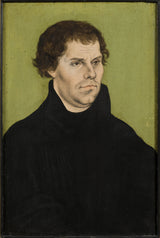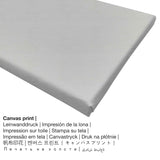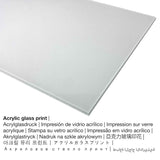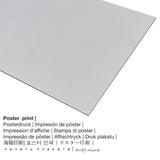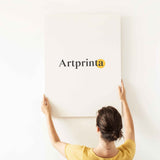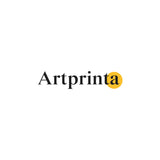Lucas Cranach the Elder, 1527 - Martin Luther - mbipụta nka mara mma
Ụtụ gụnyere. Mbupu gbakọrọ na ndenye ọpụpụ.
Nkọwapụta ngwaahịa
In 1527 Lucas Cranach the Elder made the masterpiece named "Martin Luther". Nke mbụ tụrụ nha: Ogologo: 39 cm (15,3 ″); Obosara: 26 cm (10,2 ″) Ekebere: Elu: 55 cm (21,6 ″); Obosara: 43 cm (16,9 ″); Omimi: 3 cm (1,1 ″). The piece of art belongs to the digital collection of Nationalmuseum Stockholm, which is Sweden's museum of art and design, a Swedish government authority with a mandatet o preserve cultural heritage and promote art, interest in art and knowledge of art. We are happy to reference that the work of art, which is part of the public domain is being provided with courtesy of Nationalmuseum Stockholm & Wikimedia Commons.: . Furthermore, alignment is portrait and has an image ratio of 2: 3, nke pụtara na ogologo bụ 33% mkpụmkpụ karịa obosara. The painter Lucas Cranach the Elder was an artist from Germany, whose artistic style can be classified as Northern Renaissance. The artist was born in the year 1472 na Kronach, Bavaria, Germany na nwụrụ anwụ na afọ nke 81 Na 1553 na Weimar, Thuringia, Germany.
Nye iwu ihe ị ga-atụkwasị na mgbidi gị
Na menu ndọpụta ngwaahịa ị nwere ike họrọ nha na akụrụngwa masịrị gị. Ka ị kwekọọ n'ihe ị chọrọ nke ọma, ị nwere ike họrọ n'ime nhọrọ nhazi ngwaahịa ndị a:
- Akwụkwọ mmado ebipụtara (akwa akwa akwa): A poster print is a printed flat cotton canvas paper with a slight finish on the surface. Please keep in mind, that depending on the absolute size of the poster we add a white margin between 2 - 6cm around the painting in order to facilitate the framing.
- Aluminom dibond mbipụta (ọla): An Aluminium Dibond print is a material with a true depth effect, creating a modern look throuch a surface structure, which is not reflective. A direct Direct Print on Aluminum Dibond is your perfect start to art prints with aluminum. For the Print On Aluminum Dibond, we print your chosen work of art onto the aluminium white-primed surface.
- Mbipụta kanvas: A canvas print, not to be mistaken with a painting on a canvas, is a digital copy printed on a canvas fabric. It creates a typical effect of three dimensionality. Further, a canvas generates a cosy and comfy appearance. The advantage of canvas prints is that they are relatively low in weight, meaning that it is easy to hang up your Canvas print without the help of additional wall-mounts. Therefore, canvas prints are suitable for all kinds of walls.
- Mbipụta iko acrylic (nke nwere ezigbo mkpuchi iko): The print on acrylic glass, often labelled as a plexiglass print, makes the artwork into stunning home décor and offers a good alternative option to dibond and canvas fine art prints. Your own version of the work of art will be custom-made with the help of modern UV direct printing technology. The major benefit of an acrylic glass fine art copy is that contrasts and also details become more exposed thanks to the granular gradation in the print.
Nkwupụta iwu: We try all that we can in order to depict the products in as much detail as possible and to display them visually. At the same time, the colors of the printing material, as well as the print result may diverge somehwat from the representation on your device's monitor. Depending on your screen settings and the condition of the surface, color pigments may not be printed one hundret percent realistically. Bearing in mind that all the art reproductions are processed and printed by hand, there may as well be minor variations in the motif's exact position and the size.
Nkọwa ngwaahịa
| Nkewa edemede: | mmepụta nka |
| Mmeputakwa: | dijitalụ mmeputakwa |
| Usoro nhazi: | mbipụta dijitalụ |
| Mmalite ngwaahịa: | arụpụtara na Germany |
| Ụdị ngwaahịa: | mmepụta ihe na-achọ |
| A na-atụ aro iji ngwaahịa eme ihe: | Nhazi ụlọ, mkpokọta nka (mmeputakwa) |
| Nhazi nka nka: | usoro eserese |
| Oke akụkụ onyonyo: | 2: 3 |
| Mmetụta akụkụ: | ogologo bụ 33% mkpụmkpụ karịa obosara |
| Ihe mmeputakwa dị: | acrylic glass print (nwere ezigbo mkpuchi iko), mbipụta akwụkwọ mmado (akwụkwọ kwaaji), mbipụta ọla (aluminium dibond), mbipụta akwụkwọ. |
| Mbipụta kanvas (akwa akwa na etiti ihe ndọtị) dị iche iche: | 20x30cm - 8x12", 40x60cm - 16x24", 60x90cm - 24x35", 80x120cm - 31x47", 100x150cm - 39x59" |
| Mbipụta iko acrylic (nke nwere ezigbo mkpuchi iko): | 20x30cm - 8x12", 40x60cm - 16x24", 60x90cm - 24x35", 80x120cm - 31x47", 100x150cm - 39x59" |
| Nhọrọ nha nke akwụkwọ mmado (akwụkwọ kwaaji): | 40x60cm - 16x24", 60x90cm - 24x35", 80x120cm - 31x47" |
| Nhọrọ aluminom dibond (ihe aluminom) nhọrọ: | 20x30cm - 8x12", 40x60cm - 16x24", 60x90cm - 24x35", 80x120cm - 31x47" |
| Igwe onyonyo: | agunyeghi |
Tebụl ihe osise
| Aha nke ihe nka: | "Martin Luther" |
| Nhazi nka nka: | sere |
| Otu sara mbara: | nka ochie |
| Nhazi oge: | 16th narị afọ |
| Emepụtara n'afọ: | 1527 |
| Afọ nka: | 490 afọ |
| Akụkụ izizi (ọrụ nka): | Ogologo: 39 cm (15,3 ″); Obosara: 26 cm (10,2 ″) Ekebere: Elu: 55 cm (21,6 ″); Obosara: 43 cm (16,9 ″); Omimi: 3 cm (1,1 ″) |
| Egosiputara na: | National Museum nke Stockholm |
| Ebe ebe ngosi nka: | Stockholm, Obodo Stockholm, Sweden |
| Weebụsaịtị ihe ngosi nka: | National Museum nke Stockholm |
| Ụdị nka nka: | ngalaba ọha |
| Site n'aka: | Nationalmuseum Stockholm na Wikimedia Commons |
Nchịkọta ihe nkiri
| Aha onye nka: | Lucas Cranach Onye Okenye |
| Aha utu aha: | Cranak, Lucas Müller genannt Sunders, Kronach Lucas, Cranach Lucas I, Lucas Cranache, Lukas Cranach D. Ä., Lukas Cranach d. Ae., Cronach, L. Cranack, Lucas Cranaccio, Muller Lucas, Lucas Krane, Lucas Kraen, Kranakh Luka, Lucas Cranack, Kranach, von Lucas Müller genannt Cranach dem Alten, cranach lucas d. alt., Lucas Cranach d.Äe., L. Cranach, von Lucas Kranach dem ältern, Luc. Kranachen, Luc Cranach, Moller Lucas, Luca Cranach, cranach lucas d. a., קראנאך לוקאס האב, Luc. Kranach, Cranach Lucas (The Elder), lucas cranach d. aelt., cranach lucas d. ae., l. cranach d. aelt., Cranach d. Ä. Lucas, Lucas de Cronach, Cranaccio, Lucas Granach, Cranach Lucas d. Ält., Cranach des Älteren, Lukas Cranach, Sonder Lucas, Cranach Lucas the elder, L. Kranachen, Luckas Cranach d. Ä., L. Cranache, Lucas Cranach D. Ältere, Lucas de Cranach, Luca Cranch, Lucas de Cranach le père, l. cranach d. alt., Lucas Cranik, Lucius Branach, lucas cranach d. a., cranach lucas d.a., cranach lucas der altere, Sunder Lucas, lucas cranach d. alt., Lucas I Cranach, L. Cranac, L. von Cranach, lukas cranach der altere, cranach the elder lucas, Lucas Cranach der Ältere, Cranach Lucas Der Ältere, L. Cranaccio, Lucas Kranack, lucas cranach d.Ä.lt, Luca Kranack, Luc. Cronach, Maler Lucas, Lukas Cranach dem Aeltern, Kranach Lukas, Cranach Muller, Cranach Lukas d. Ä., Lucas van Cranach, L. Kranach, Lucas Cranach, cranach lukas d. ae., älteren Lucas Cranach, lucas cranach d. ae., L. Kronach, Cranach the Elder Lucas, Lucas Müller genannt Cranach, Luc Kranach, Cranach Lukas, Cranach Sunder, Cranach Lucas van Germ., Cranach, Lucas Kranach, Cranach Luc., Lucas Kranich, Lucas Cranach the Elder, Lucas Cranch, Lukas Cranach d.Ä., l. cranach der altere, Cranach Lukas Der Ältere, Cranach Lucas van, Cranach Lukas d. Ae., Cranack, Cranach Lukas d.Äe., Lucas Kranachen, Luca Kranach, Lucas Cranach d.Ä., Cranach Lukas d. A., Cranach Lucas, Lucas Müller genannt Cranach, cranach lucas the elder, Luc. Cranach, Lucas (The Elder) Cranach |
| okike onye nka: | nwoke |
| Obodo onye nka: | German |
| Ọrụ: | onye na-ese ihe |
| Obodo onye nka: | Germany |
| Otu nka: | nna ukwu ochie |
| Ụdị nke onye na-ese ihe: | Northern Renaissance |
| Afọ ọnwụ: | 81 afọ |
| Afọ amụrụ: | 1472 |
| Ebe omuma: | Kronach, Bavaria, Germany |
| Nwụrụ n'afọ: | 1553 |
| Nwuru na (ebe): | Weimar, Thuringia, Germany |
© nwebiisinka site na - Artprinta.com

